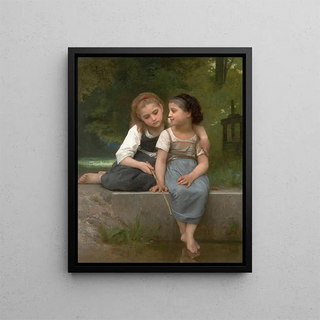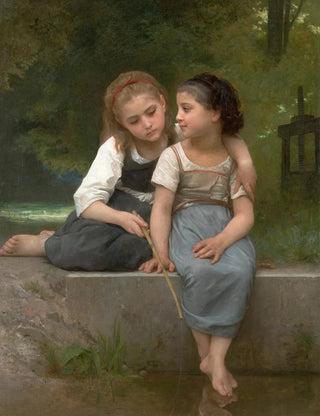Art print | Frog Catching - William Bouguereau


View from behind

Frame (optional)
Pêche aux grenouilles - William Bouguereau – Captivating Introduction
In the world of art, some works manage to capture the very essence of everyday life with such finesse that they transcend their era. "Frog Catching" by William Bouguereau is one of these masterpieces. Created at the end of the 19th century, this painting depicts a bucolic scene where children engage in a simple yet charming activity. The viewer's gaze is immediately drawn to the softness of their faces, the light dancing on the water, and the surrounding nature, creating an atmosphere of serenity and wonder. Bouguereau, an undisputed master of realism, succeeds here in bringing fleeting moments to life, inviting everyone to rediscover the beauty of simple pleasures.
Style and uniqueness of the work
The originality of "Frog Catching" lies in how Bouguereau blends realism with a touch of romanticism. Every detail, from the splashes of water to the expressions of the children, is meticulously crafted, demonstrating impeccable technique. The vibrant colors and play of light are as many elements that breathe vitality into the composition. Bouguereau excels in depicting the human body, and in this work, he manages to capture the joy of childhood while highlighting the beauty of nature. The forms are rounded, the faces radiant, and each gesture of the children seems charged with disarming innocence. This blend of realism and poetry gives the artwork a timeless dimension, allowing the viewer to escape into a world where nature and humanity coexist in harmony.
The artist and his influence
William Bouguereau, an emblematic figure of French academicism, established himself as a master of painting in the 19th century. His artistic journey is marked by a desire to represent reality with an almost photographic precision. Bouguereau was heavily influenced by classical traditions, but he also knew how to incorporate contemporary elements into his work. His style inspired many artists, both through his technique and his ability to evoke deep emotions. By choosing themes related to the

Matte finish

View from behind

Frame (optional)
Pêche aux grenouilles - William Bouguereau – Captivating Introduction
In the world of art, some works manage to capture the very essence of everyday life with such finesse that they transcend their era. "Frog Catching" by William Bouguereau is one of these masterpieces. Created at the end of the 19th century, this painting depicts a bucolic scene where children engage in a simple yet charming activity. The viewer's gaze is immediately drawn to the softness of their faces, the light dancing on the water, and the surrounding nature, creating an atmosphere of serenity and wonder. Bouguereau, an undisputed master of realism, succeeds here in bringing fleeting moments to life, inviting everyone to rediscover the beauty of simple pleasures.
Style and uniqueness of the work
The originality of "Frog Catching" lies in how Bouguereau blends realism with a touch of romanticism. Every detail, from the splashes of water to the expressions of the children, is meticulously crafted, demonstrating impeccable technique. The vibrant colors and play of light are as many elements that breathe vitality into the composition. Bouguereau excels in depicting the human body, and in this work, he manages to capture the joy of childhood while highlighting the beauty of nature. The forms are rounded, the faces radiant, and each gesture of the children seems charged with disarming innocence. This blend of realism and poetry gives the artwork a timeless dimension, allowing the viewer to escape into a world where nature and humanity coexist in harmony.
The artist and his influence
William Bouguereau, an emblematic figure of French academicism, established himself as a master of painting in the 19th century. His artistic journey is marked by a desire to represent reality with an almost photographic precision. Bouguereau was heavily influenced by classical traditions, but he also knew how to incorporate contemporary elements into his work. His style inspired many artists, both through his technique and his ability to evoke deep emotions. By choosing themes related to the






